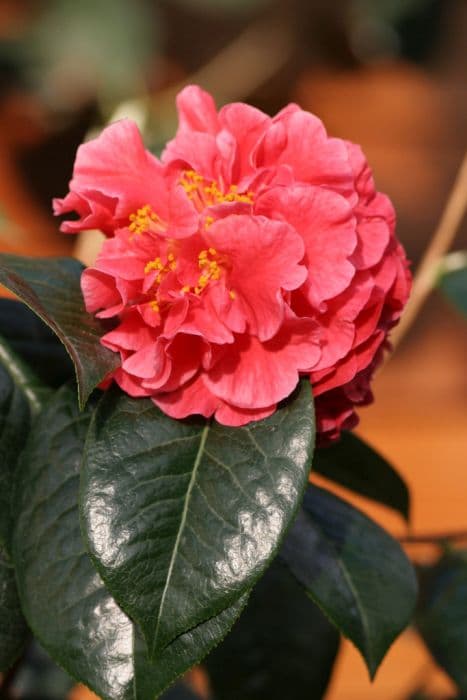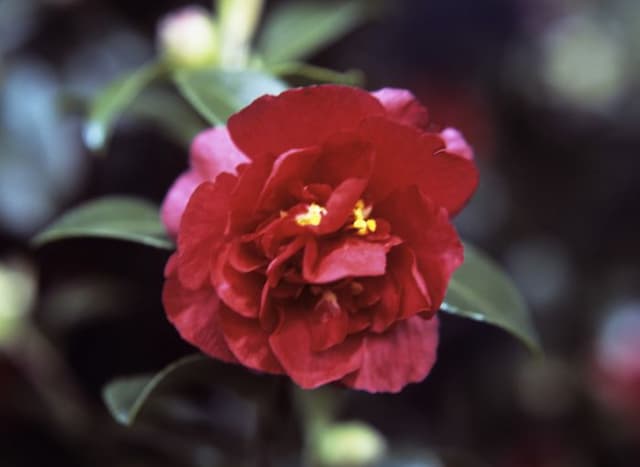Carlyon Camellia Camellia 'Tristrem Carlyon' (reticulata hybrid)

ABOUT
Camellia 'Tristrem Carlyon' is a striking ornamental shrub known widely for its showy flowers and lush foliage. The plant sports glossy, deep green leaves with a leathery texture, providing a rich backdrop for its blooms. The flowers make a dramatic statement with their size and form. They are large, semi-double to peony-form blooms with elegantly ruffled petals. Typically, the flowers exhibit a vibrant shade of deep pink, with the edges of the petals sometimes appearing slightly lighter. In the center of each blossom, yellow stamens can be seen, offering a delicate contrast to the boldness of the pink petals. The plant blooms profusely, producing an abundance of flowers that can create a stunning display during its flowering season, transforming the shrub into a centerpiece of visual interest in any garden setting. The overall appearance of Camellia 'Tristrem Carlyon' exudes elegance and provides a romantic touch to the landscape.
About this plant
 Names
NamesFamily
Theaceae.
Synonyms
Carlyon Camellia, Tristrem Carlyon Reticulata Camellia, Tristrem Carlyon Camellia.
Common names
Camellia 'Tristrem Carlyon' (reticulata hybrid).
 Toxicity
ToxicityTo humans
Camellia's (Camellia 'Tristrem Carlyon' - reticulata hybrid) are generally considered non-toxic to humans. If ingested, they are unlikely to cause any significant or harmful symptoms. However, individuals may have varying sensitivities, and in rare cases, ingestion could potentially cause mild gastrointestinal discomfort, but there is no widespread documentation of serious poisonings from consuming parts of the Camellia plant.
To pets
The Camellia plant (including Camellia 'Tristrem Carlyon' - reticulata hybrid) is also generally recognized as non-toxic to pets such as dogs and cats. It is not expected to cause serious illness if pets consume parts of the Camellia. However, as with humans, individual animals may react differently, and ingestion could potentially result in mild gastrointestinal upset. It is always wise to monitor pets if they have ingested any plant material and consult a veterinarian if any adverse effects are observed.
 Characteristics
CharacteristicsLife cycle
Perennials
Foliage type
Evergreen
Color of leaves
Green
Flower color
Pink
Height
8-12 feet (2.4-3.7 meters)
Spread
6-10 feet (1.8-3 meters)
Plant type
Shrub
Hardiness zones
8
Native area
China
Benefits
 General Benefits
General Benefits- Aesthetic Appeal: The Camellia 'Tristrem Carlyon' features large, showy flowers that offer visual interest and enhance garden beauty.
- Year-Round Foliage: It has evergreen leaves that provide a continuous display of glossy green foliage throughout the year.
- Landscape Versatility: It can be used in various landscape designs, including hedges, foundation plantings, and as a specimen plant.
- Attracts Wildlife: The blossoms can attract pollinators such as bees and butterflies to the garden.
- Shade Tolerance: This plant is capable of thriving in partial shade, making it suitable for understory planting or shaded garden areas.
- Drought Resistance: Once established, it has moderate tolerance to drought conditions, reducing the need for frequent watering.
- Long Blooming Season: The Camellia 'Tristrem Carlyon' has a lengthy blooming period which may extend from late winter to early spring, providing color when few other plants are in bloom.
 Medical Properties
Medical PropertiesThis plant is not used for medical purposes.
 Air-purifying Qualities
Air-purifying QualitiesThis plant is not specifically known for air purifying qualities.
 Other Uses
Other Uses- Creating Bonsai: Reticulata camellias, including 'Tristrem Carlyon', can be cultivated as bonsai plants, offering a unique challenge due to their larger leaf size and flower, which requires careful pruning and shaping.
- Artistic Inspiration: Artists may be inspired by the vivid flowers of 'Tristrem Carlyon' for paintings, photography, or fabric designs, capturing its beauty in various artistic mediums.
- Special Occasion Decor: The striking blossoms of 'Tristrem Carlyon' can be used in table arrangements or venue decorations for weddings and other formal events.
- Culinary Decoration: Although not consumed, the petals of 'Tristrem Carlyon' can be used to elegantly decorate desserts and cocktails for a sophisticated visual appeal.
- Educational Use: Botanical schools and gardens may use 'Tristrem Carlyon' to teach about plant hybridization and the genetics of flowering plants.
- Photography Workshops: With its stunning flowers, 'Tristrem Carlyon' provides an ideal subject for macro photography workshops, focusing on flower photography skills.
- Eco-friendly Confetti: Dry the petals of 'Tristrem Carlyon' to create natural, biodegradable confetti for celebrations, offering an environmentally friendly alternative to traditional paper or plastic confetti.
- Horticultural Competitions: Gardeners may grow 'Tristrem Carlyon' specifically for entering in flower shows or horticultural competitions, where its large and vibrant flowers can be particularly show-stopping.
- As a Gift Plant: Due to its attractive appearance when blooming, 'Tristrem Carlyon' camellias can be potted and given as living gifts for housewarmings or as a symbol of gratitude.
- Plant Breeding: Reticulata hybrids like 'Tristrem Carlyon' can be crossbred with other camellia varieties to create new hybrids with diverse flower colors and forms.
Interesting Facts
 Feng Shui
Feng ShuiThe Camellia is not used in Feng Shui practice.
 Zodiac Sign Compitability
Zodiac Sign CompitabilityThe Camellia is not used in astrology practice.
 Plant Symbolism
Plant Symbolism- Admiration: Camellias, like the 'Tristrem Carlyon', are often associated with deep admiration for someone's accomplishments or qualities.
- Perfection: Due to its perfectly symmetrical form and elegant appearance, camellias can symbolize the ideal or perfection.
- Longevity and Faithfulness: Camellias are evergreen plants, which conveys a message of eternal love or long-lasting devotion.
- Affection: The lush and attractive bloom of the camellia signifies a romantic or platonic affection towards someone.
- Gratitude: Giving camellias can be a way of expressing thankfulness to someone, making it a symbol of gratitude.
 Water
WaterFor the Camellia 'Tristrem Carlyon', or Camellia, ensure that the soil remains moist, but not waterlogged. Watering should be done deeply, saturating the root zone, about once a week, but may need to increase to twice a week during hot, dry spells. A general rule is to apply roughly 1 to 1.5 gallons per watering for a medium-sized plant, adjusting for weather conditions and soil drainage. During the winter, reduce watering frequency to account for lower evaporation rates. It’s vital to avoid overhead watering to prevent fungal diseases; instead, apply water directly at the base of the plant.
 Light
LightFor Camellia 'Tristrem Carlyon', or Camellia, provide partial shade with some protection from the hot afternoon sun, especially in warmer regions. An ideal spot would be under a high tree canopy that filters sunlight. Ensure that the plant receives bright, indirect light for the healthiest growth; direct morning sunlight is tolerated but should be limited to prevent leaf scorch.
 Temperature
TemperatureCamellias thrive in temperatures between 60°F and 80°F. They can survive minimal dips to around 20°F but should be protected from prolonged exposure to freezing conditions. The ideal temperature range for Camellia 'Tristrem Carlyon' is between 70°F and 75°F during the day and a slight drop to around 60°F to 65°F at night for optimal growth.
 Pruning
PruningPrune Camellia 'Tristrem Carlyon' immediately after blooming to maintain shape and remove any dead or weak growth. This practice encourages bushier growth and more blooms for the next season. Seasonal pruning helps to enhance air circulation and light penetration, which are crucial for the plant's health. Generally, pruning once a year is sufficient for this Camellia.
 Cleaning
CleaningAs needed
 Soil
SoilCamellias require acidic, well-draining soil with a pH between 5.5 and 6.5. An ideal mix for Camellia 'Tristrem Carlyon' would be equal parts of peat moss, pine bark, and coarse sand or perlite to ensure good aeration and moisture retention. Regularly test soil pH to maintain the acidity required for optimal growth.
 Repotting
RepottingCamellias, including the 'Tristrem Carlyon', generally need repotting every 2-3 years. They prefer to be somewhat root-bound, so repotting too frequently is unnecessary. Choose a slightly larger pot when repotting to encourage growth without causing stress to the plant.
 Humidity & Misting
Humidity & MistingCamellias thrive in environments with high humidity, preferred at 40-60%. The 'Tristrem Carlyon' will benefit from being placed on a pebble tray with water or regular misting to maintain the required humidity levels, especially in drier indoor climates.
 Suitable locations
Suitable locationsIndoor
Place 'Tristrem Carlyon' in bright, indirect light; keep soil moist.
Outdoor
Plant 'Tristrem Carlyon' in partial shade; shelter from cold winds.
Hardiness zone
7-10 USDA
 Life cycle
Life cycleThe Camellia 'Tristrem Carlyon' begins its life cycle when a seed germinates in the soil, often in spring or when temperatures are appropriate for growth. It progresses to a seedling, developing its first set of true leaves after the initial embryonic leaves (cotyledons). As a juvenile, the camellia then transitions into vegetative growth, forming a small shrub that will mature over several years. During its maturity, it produces large, ornate flowers usually in late winter to early spring, which, if pollinated, will lead to the formation of seed pods. Once mature, 'Tristrem Carlyon' can live for many years, annually undergoing cycles of growth, flowering, and seed production. The plant eventually reaches old age where growth slows, and it may become less vigorous before eventually dying.
 Propogation
PropogationPropogation time
Spring to early summer
The most popular method of propagating the Camellia 'Tristrem Carlyon', a reticulata hybrid commonly known as the camellia, is through semi-hardwood cuttings. This process typically takes place during summer or early fall, when the plant's growth begins to slow down and the wood hardens slightly but is not yet completely mature. The cuttings should be about 4 to 6 inches long, with leaves removed from the lower half to expose the nodes where roots will form. The cut end of the cutting is dipped in rooting hormone to encourage root development. Afterwards, the cutting is placed in a well-draining potting mix and kept in a humid environment with indirect sunlight. It's crucial to maintain the moisture level without letting the cutting sit in waterlogged soil. Rooting can take a few months, after which the rooted cuttings can be transplanted into individual pots to grow on before planting out.









